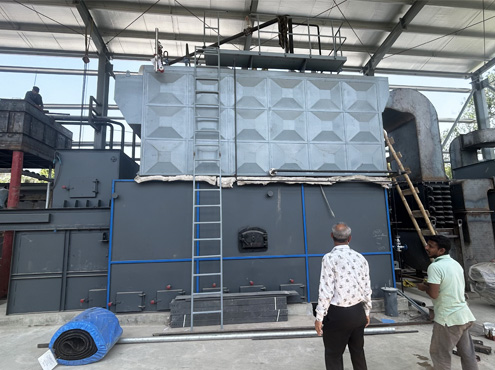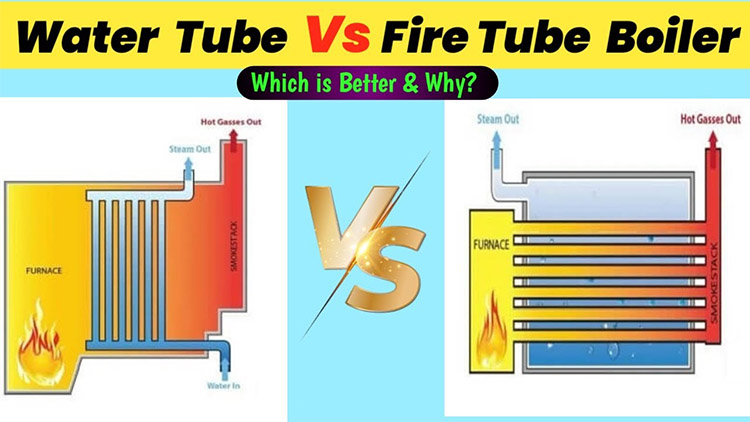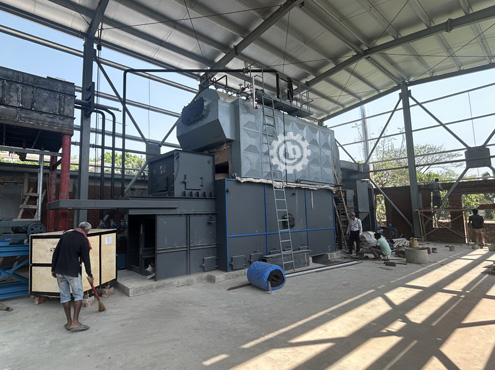Industrial steam boilers play an indispensable role in industrial production, performing the critical task of transferring heat from one place to another. As a pressure vessel, a steam boiler efficiently transports heat from the boiler room to the point of use, providing power and thermal support for a variety of production activities. However, due to the inherent dangers associated with the operation of steam boilers, their manufacture and operation are regulated by strict regulations. Simply put, a boiler is an internally heated heat exchanger used to output steam or hot water. In this article, we will provide you with a detailed analysis of the key points of industrial steam boiler selection to help you make a scientific decision.

An industrial steam boiler is a pressure vessel used to transfer heat from one place to another within a factory. It heats water to steam or hot water through an internal heat exchange mechanism for efficient heat transfer. Due to the inherent risks associated with the operation of steam boilers, they are manufactured and operated in accordance with strict safety regulations, such as pressure control standards and emission regulations.
Industrial steam boilers are widely used in the food processing, chemical, pharmaceutical, and power generation industries. For example, food processing plants require steam for sterilization and processing, power plants rely on high-pressure steam to drive turbines to generate electricity, and commercial buildings use it for central heating.

Firetube boilers are a highly efficient and popular type of boiler that is used in a variety of industries due to its low maintenance costs, high efficiency and reliability. It works by heating water to boiling, creating high-pressure steam and using the steam pressure to drive a turbine or other power equipment. A fire tube boiler mainly consists of a boiler shell, combustion chamber, flue tube (fire tube), water tube and boiler fittings.
During operation, water flows from the outer cylinder into the inner tubes and is heated to a boiling state along the tubes. Steam is eventually discharged through the exhaust port and transported through the tubes to where it is needed to drive mechanical equipment or for heating, etc. In industries such as food processing plants, chemical plants, and pharmaceutical companies, fire-tube boilers are the best solution for producing the large quantities of hot water or steam needed, and they also demonstrate excellent fuel consumption performance in heating systems for residential and commercial buildings. In addition, fire tube boilers operate with monitors that detect temperature and pressure in real time, and maintenance is as simple as regular cleaning and replacement of parts.
Water tube boiler is an energy-saving heating equipment that utilizes water circulation to achieve heat transfer. Its main structure includes a boiler cylinder, an internally arranged convection tube bundle and an exhaust device, and the special structural design effectively improves the heat transfer efficiency. Water is heated from the low-temperature region through the water tube and then returned to the cylinder, forming a closed cycle. Water tube boilers are usually categorized into types such as natural circulation boilers and forced circulation boilers.
As pure, non-polluting ordinary water is used as the working medium, water tube boilers do not produce any waste and secondary pollution during operation, which is fully in line with the environmental requirements of today's society. Moreover, the circulating heating method makes it more energy-efficient than traditional boilers, and the operation cost is more economical. Because of its ability to withstand high pressure, water tube boilers are commonly used in industrial scenarios that require large quantities of high-pressure steam, such as power plants, chemical plants, paper mills, food processing plants, and other large industrial sites.
Electric boilers use electrical energy as an energy source and convert it into heat energy through resistance heating elements to produce steam or hot water. Unlike gas and oil boilers, electric boilers do not require fuel combustion, so there is no exhaust gas emission, and they are environmentally friendly and non-polluting. It usually consists of heating elements, control system and safety devices.
During the heating process, the electric boiler converts electric energy directly into heat energy, which makes energy utilization more efficient and environmentally friendly compared to coal-fired or gas-fired boilers. Electric boilers are compact and easy to install, and can be flexibly arranged in places where heating is required, suitable for heating and hot water supply needs in a variety of scenarios, such as residential, commercial and industrial, etc. They have obvious advantages in reducing pollutant emissions and improving the efficiency of energy utilization, which is in line with the needs of modern society for cleaner and more sustainable development.

Biomass boiler is a kind of thermal energy equipment that can utilize renewable energy, using wood, straw, vegetable oil and other biomass as fuel, and releasing heat energy through high temperature and high pressure. This technology not only can effectively utilize renewable resources, but also has great significance in promoting sustainable development.
The use of biomass boilers can replace traditional fossil energy and reduce dependence on limited resources; help reduce carbon emissions and mitigate the impact of climate change; can promote the development of the agricultural circular economy model, convert waste into renewable energy, reduce treatment costs and drive the development of the relevant industrial chain; the use of the process can also be recycled beneficial elements to reapply to the soil to promote crop cultivation, improve land utilization rate The use of
According to the working pressure, industrial steam boilers can be divided into high-pressure boilers and low-pressure boilers, both of which are used to generate steam, but there are obvious differences. High-pressure boilers are usually capable of reaching steam pressures of 3MPa or more, while low-pressure boilers are generally capable of reaching pressures of 2MPa or less.
In terms of structure, due to the need to withstand higher temperatures and pressures, high-pressure boilers are usually made of steel, structural design is more complex, rigorous; low-pressure boilers are relatively low material requirements, mostly made of iron or copper. In terms of application, high-pressure boilers are commonly used in industrial production requiring high-temperature and high-pressure steam, such as power plants to generate electricity, chemical plant production, etc.; low-pressure boilers are mainly used for general heating and hot water supply, as well as industrial processes that do not have high temperature requirements, such as heating and hot water supply for buildings, schools and hotels, as well as hot water demand in the field of food processing, washing and so on.
The modular boiler design concept allows boiler systems to be better adapted to the needs of companies at different stages of development. Whether it is an increase or decrease in production capacity or a technological upgrade, it can be realized by adding, deleting or replacing modules.
Its flexibility is reflected in the customization according to the actual needs of enterprises, enterprises can be based on the current scale of production, energy demand and environmental standards, choose the right combination of modules to build a boiler system to meet their needs, to avoid waste of resources and improve energy efficiency; scalability to provide strong support for the development of enterprises, with the expansion of the scale of the enterprise or the increase in demand for production, the boiler system can be expanded by adding new modules to expand capacity In addition, each module of the modular boiler is an independent unit, which can be maintained, replaced or upgraded individually without affecting the normal operation of the whole system, which is easy to maintain and provides the possibility of future technological upgrading for the enterprise.
Combination boiler is a kind of equipment with dual functions of heating and hot water production, this design makes it possible to meet the heating demand at the same time, but also for residential or industrial sites to continue to provide sufficient hot water, greatly simplifies the equipment configuration, improves energy efficiency, and facilitates the user to meet the diversified hot water needs.
Combination boilers are particularly suitable for environments with specific requirements for heating and hot water demand, such as some industrial production sites or large residential buildings, where they can meet large and stable heating and hot water demand. At the same time, the compact structure and flexible installation methods make it the ideal choice for these environments. In addition, with efficient combustion and heat exchange technology, the combi boiler can ensure the heating effect while minimizing energy waste and lowering the user's operating costs, helping to achieve the goals of environmental protection and sustainable development.
Net Steam Flow Requirement: Determining the capacity of the boiler is critical, and is directly related to the optimal efficiency of production. It is necessary to accurately assess the required heat or steam load based on the parameters of the production process to determine the appropriate net steam flow rate (in kg/h or tons/h).
Pressure Required for the Process: Defining the pressure required for the production process can have an immediate effect on reducing production costs and improving operational efficiency. The right pressure setting can effectively reduce the production cost per kilogram of steam.
Fuel Availability: Fuel selection is one of the key factors in the selection process. Current and future fuel availability, as well as local emission standards, should be taken into account to ensure that the boiler is equipped with appropriate pollution treatment equipment.
Emission regulations: The emission regulations of the place where the boiler is installed place strict restrictions on the selection of the type, to ensure that the selected boiler meets the local emission requirements, is the basis of the company's compliant operation.
Price: Price is a factor that should not be ignored when selecting a model, but you can't just pursue a low price. Although the budget should be considered, choosing a cheap, poor quality boiler may face high maintenance costs at a later stage, or even need to be replaced early, instead of increasing costs.
Size: The boiler size needs to fit the boiler room space, and it is usually desirable to have a smaller boiler footprint to save space and reduce costs. Modular design of the boiler in this regard has significant advantages, without the need for traditional boilers such as reserved space for pumping tube space and open the door space, can effectively utilize the boiler room space, and even through a number of modular boilers work together to further improve efficiency and reduce operating costs.
Safety: Safety is a primary concern when purchasing a boiler, and you should choose a manufacturer with a proven track record in safety. Miura boilers, for example, are uniquely designed to virtually eliminate the possibility of catastrophic explosions and are equipped with a range of safety precautions that can prevent serious problems and catch minor malfunctions before they become major issues.
Efficiency and lifecycle: Boiler efficiency has a direct impact on operating costs, with inefficient boilers consuming more fuel, leading to higher energy bills. Therefore, investing in a high-quality, high-efficiency boiler, while costing more upfront, will result in considerable long-term savings in energy costs over a 15 - 20 year boiler life cycle.
Maintenance: The maintenance needs of a boiler are related to its service life and operational stability. Low-quality boilers may require frequent repairs, which not only adds to the cost, but may also shorten the service life. Regular maintenance and annual inspections, combined with a professional maintenance program, such as Miura's routine inspection service that requires only 3 hours of downtime, will ensure that your boiler operates efficiently and safely over the long term.
Contact suppliers during the planning stage to provide process parameters (e.g., steam pressure, fuel type) for a customized solution. For example, a chemical company can compare the sizing options for a water tube boiler (high pressure) versus a fire tube boiler (cost).
A dairy needs 5t/h steam for pasteurization (pressure 8kg/cm²), and chooses a fire tube boiler after comparison:
Reason: medium pressure requirement, easy maintenance, low initial cost;
Optimization point: equipped with condensation recovery device to improve thermal efficiency to 92%.
Take a 10-year cycle, assuming a fuel cost of $3/m³ and 5,000 hours of annual operation:
High-efficiency boiler (95% efficiency): annual fuel cost = 5t/h × 5000h × 600000kcal/t ÷ (95% × 8600kcal/kWh) × $3 ≈ 526,000 yuan;
Inefficient boiler (80% efficiency): annual fuel cost ≈ 632,000 yuan, a difference of more than 1 million yuan in 10 years.
A suitable installation location is critical to the performance and safety of an industrial steam boiler. The installation site should be spacious and well ventilated to ensure efficient operation of the boiler while allowing for safe dispersion of emissions. In addition, the distance to the fuel source and water source should be considered. Shortening the distance for fuel transportation and water supply can save time and cost. When choosing a location for installation, it is also important to ensure that the boiler is easily accessible for maintenance and inspection, that local safety regulations are strictly adhered to, and that the environmental impact of the boiler's emissions is assessed to ensure compliance with the relevant regulations.
Maintenance is the key to extending the life of industrial steam boilers and improving operational efficiency. Establishing a regular inspection program can identify potential problems in a timely manner; establishing a cleaning schedule for flue and water pipes prevents scale buildup from affecting boiler performance; and stocking the necessary replacement parts can reduce downtime during repairs.
Boiler installations should be designed with accessibility in mind to provide convenience for technicians and maintenance personnel. Ensure there is enough space for maintenance tools and equipment, keep access to the boiler clear for inspection and repair, and plan for emergency access in case of equipment failure or safety issues.
If the boiler is installed outdoors, it must be properly protected. Use suitable insulation materials to prevent extreme temperatures from affecting boiler performance; build shelters or use waterproof and dustproof covers to protect the boiler from wind, rain, ice and snow; and ensure that the installation site is well drained to avoid damage to the boiler from standing water.
The selection of industrial steam boiler involves many aspects such as type, parameters, price, safety, maintenance, etc., each of which has an important impact on the productivity, operating costs and safety of the factory. Correct selection of industrial steam boilers, not only to ensure that the steam piping size is appropriate, steam hydrophobic system is reasonable, to achieve the optimal use of energy, but also to avoid the loss of steam due to improper selection.
In the selection process, it is recommended that enterprises and professional boiler manufacturers to fully communicate with the comprehensive consideration of all factors, to make scientific decisions for the stable production of factories and sustainable development to lay a solid foundation. With the continuous progress of technology, the future of industrial steam boiler selection will also pay more attention to environmental protection, high efficiency and intelligence, enterprises should follow the industry trend, adjust the selection strategy in time to adapt to the development needs of the times.